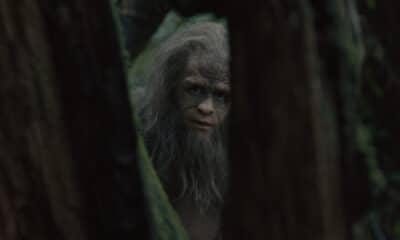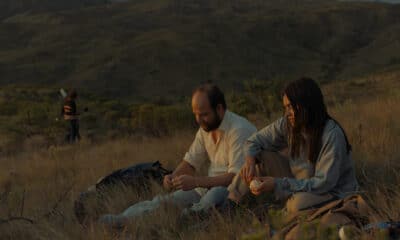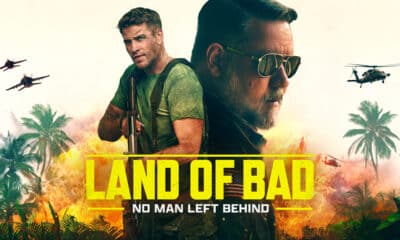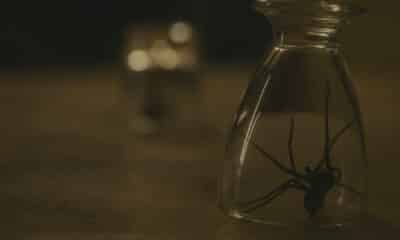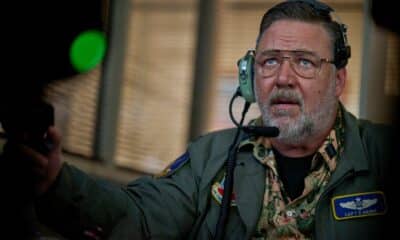Nominated for six Irish Film and Television awards, You Are Not My Mother is a brilliantly terrifying story that arrives in UK cinemas and on Digital platforms on 4th April. Directed by Kate Dolan, You Are Not My Mother joins teenager Char (Hazel Doupe ) as her mother Angela (Carolyn Bracken) disappears. When she returns home without explanation the following evening, it becomes clear to Char and her grandmother that something is amiss. She might look and sound the same, but Angela’s behaviour has become increasingly frightening, as if she has been replaced by a malevolent force. As Halloween night looms, a night steeped in ancient myth and legend, Char realises that she is the only one who can save her mother, even if it means potentially losing her forever.
Already out in cinemas in its native Ireland, ahead of the UK release You Are Not My Mother will screen at Glasgow Film Festival as part of the Arrow Video FrightFest strand. Before that, we sat down with Kate to find out more about her cinematic upbringing, the allure of folklore, and why sometimes the city is way scarier than the woods.

From what I’ve read in your previous interview it seems that we had a similar film upbringing; watching movies at a super young age with our mothers. How do you think that this experience shaped your attitude toward film?
My mum was a real cinema lover. To me it was the norm when I was a kid; we would rent movies the whole weekend and watch them on Friday and Saturday. That was just part of our relationship, always watching movies or going to the cinema together. I didn’t realise that wasn’t everyone’s experience until I got a bit older; “what do you mean you didn’t watch Shawshank Redemption with your mum when you were seven?” That was just part of life.
It really instilled a love of cinema. I saw a lot of films when I was very young that really showed me what you could do with a film. Not just kids films, but bigger more adult films. I was really gripped by them. My mum never talked down to me or patronised me in terms of, “oh you’re not going to understand this film.” It was always, “watch it and see what you think.” It gave me a good education in terms of cinema quite early on. My granny as well was a real cinema lover. She had a lot of the old classics like Gone with the Wind, which I watched with her. It was a different education, but she had an encyclopaedic knowledge for films. I think it backfired for my mum though because then she was, “oh no, now she wants to be a film director instead of doing law or something.”
You Are Not My Mother has to have one of the most brutal openings in movie history. At what stage did you decide that scene was going to ‘welcome’ the viewer to this world?
I think that was very early, because the film was very much inspired by the Changeling myth. The key element of that myth is that people burned their babies, or would drown their babies because they thought that their babies were replaced by something else. Those are true stories that actually happened. Because of the folklore, the fairy tales essentially felt so powerful and real to people that they believed it to be true. Those stories were really dark and tragic. It then just made that a no-brainer as the intro to the film for me. I think that was one of the first things that I wrote. I knew because we had a low budget film that it needed to be an opening that felt really impactful. It had to say, “this is what the film is” from the beginning. I think that horror films are great in that way. I love teaser openings that really grab an audience by the neck from the very beginning.

Folklore and woodland sprites tend to have their stories told within the surroundings of nature. Here they are placed in the concrete jungle of a council estate. What difference do you think that this setting gives the story?
At first it was just because, as you said, any folk horror films I’ve seen are always ‘the cabin in the woods’, then the things in the woods get the family that have moved there. For me, I felt that I had seen that so much. I grew up in Dublin, just outside the city, which is very urban. I felt that the folklore permeated as much into culture in the urban and the suburban areas in Ireland. It was still so much a part of our upbringing to hear all those folk stories, but you’d be in a very urban space hearing them. So for me it just felt like we were missing a trick not seeing a different setting for those stories. I think it can almost be more scary to be in a terraced housing estate with people all around you and for something to be happening and for the people right beside you to do nothing. I think that’s even more scary than to be in an isolated cabin in the woods.
The film explores folklore and paganism within the structure of one family of three women. The three stages of womanhood – The Maiden, The Mother and The Crone – are strong presences within the pagan world. How closely did you try to tie Char, Angela, and Rita to each of these phases?
It’s funny because that was definitely an influence, the three goddess symbols and the Pagan heart of the film were kind of representative of these different generations of women. But I also grew up with my mother in a house with my grandmother, so it was very personal to me too because they were complex, strong, weak, stubborn, really intelligent women that I grew up with in my life that were very inspirational to me. It was something that I hadn’t really seen that much in film, or Irish film particularly. There are lots of very revered women in the Pagan side of things. Like Saint Brigid and fairy doctors that would have been like herbalists and respected in the property and able to own their property without a man. That definitely informed those characters that they were taking inspiration from that part of our history.
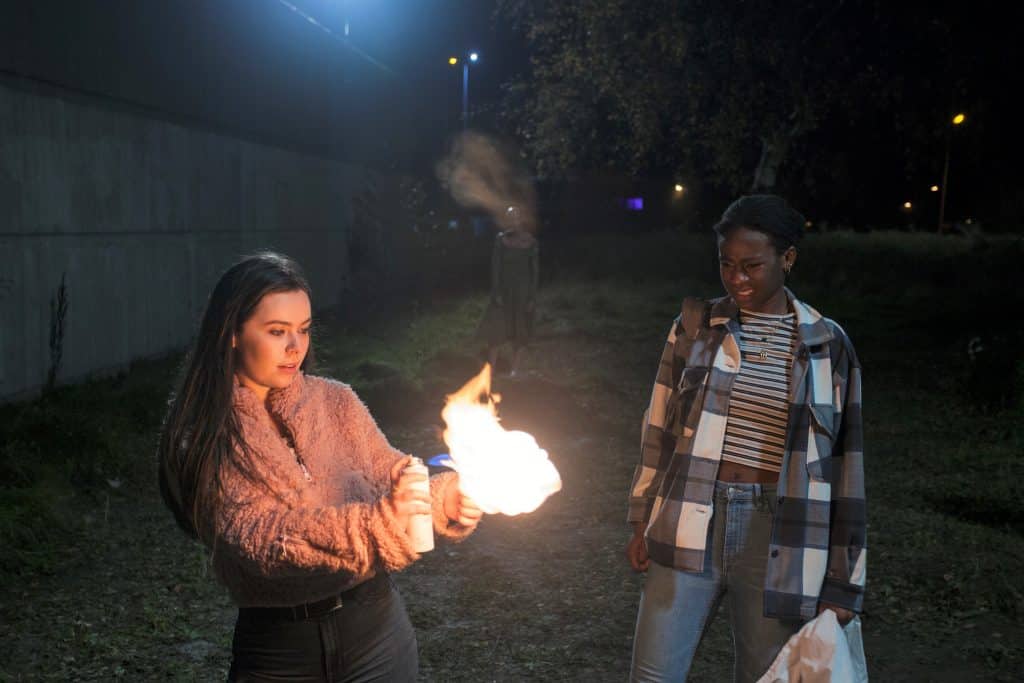
The elements of fire and water play a heavy part in the imagery; the whole purging and cleansing properties link back to various religions. What relevance do they play in You Are Not My Mother?
In Irish folklore the fire is a massive symbol, and in Irish paganism the fire is a huge part of our history in that way. People on Halloween night still light bonfires all the time. Even on Bealtaine, the 1st May, which is a Pagan festival here, people in the West light bonfires and you’re meant to jump over it. It’s really rooted in our history so when the film was set on Halloween I knew it ended on a bonfire. So then fire became a recurring part even with the smoking and the lighters, that it was ever present.
Then the antithesis of that is the water. But other water in Irish folk history has a huge part as well in terms of water spaces being liminal spaces that act as a gateway between our world and another world. I think it’s because of the reflective nature of them that they show our world back to us, but upside down.
Typically when faced with a family member no longer being themselves in cinema, that person has usually changed for the worse. Here, one could argue that Angela has been improved for Char; she’s no longer bed-ridden and spends time with her. What was it about this angle that intrigued you?
It came from two places. There was the idea that what’s happening to Angela is almost presented as a manic depressive or bi-polar disorder. People can be brilliant and effervescent in a really high stage, but then that can turn very sharply into something very frightening. But also, on the folklore side, the fairies in Irish history, they aren’t really malevolent. They’re not…in Irish folklore it’s never black or white. It’s not like there’s ever really completely evil or completely good. Everyone has a duality. I hate black and white depictions of human beings in film. I think everyone has a lot of duality. I love that about our folk history. It’s quite similar I guess to Eastern folklore. Like in places like Japan you have these characters that are ambiguous. You don’t know their motivations. They’re not really good or bad, they’re just existing. Fairies in Irish folklore operate more on just enjoying themselves to the utmost, so dancing and eating and loving life. Loving the human aspects of life almost. They’re like an Id in a way. That was a big inspiration for her. That’s what I told Carolyn Bracken, who played Angela. in the movie, where to draw from.
Outside of the supernatural horror elements, the real terror of the piece comes from the torment that Char suffers at the hand of her bullies. These moments are super intense, their cruelty being an accurate portrayal of the hardships suffered by many. Why was it important for you to show this aspect of Char’s life?
For me, the sense of place was really important. When I was a teenager if you were walking through the park, or you had to take a shortcut through a lane and there were people that you really, really didn’t want to see if you were walking through those spaces, because you knew if you looked at them the wrong way your day was about to get much worse, that was so much a part of my teen years. I think as a queer kid as well, just that aspect where you are constantly trying not to draw attention to yourself because if you do then it’s just going to be much worse, I wanted to create that sense of place. That you can’t really walk around here feeling fully safe at any time. I think the cruelty of it as well is very much inspired by, luckily no really bad experiences that I had growing up, but where I went to school and such, you heard stories of people being stabbed on their way home and all that kind of stuff. So quite vicious, cruel, and violent teenagers, which are really frightening. It was just drawing from those stories.

One aspect of You Are Not My Mother that I really liked were some of the parallels with Bernard Rose’s Candyman. There’s the estate setting, the whispered rumours, someone coming unstuck, and a big ol bonfire. Were there any films that you looked to for inspiration?
Candyman was definitely a huge influence. That’s a film that is definitely a folk horror I suppose in an urban setting. That was one of the only ones I could think of really when we were in prep on the film, so it was definitely something that I looked at. I think I like a lot of Asian horror as well because I think that their folklore is quite similar, so looking at even more recent movies like the Korean film The Wailing; that was one that I watched again. Rosemary’s Baby was also a huge reference because it’s through a character’s POV, forgetting who the film is made by, but it’s through a character’s POV that you’re seeing the film. You never break the perspective and that really amps up the tension and paranoia that Char has. The visual language of the film was informed by a good bit of that movie. There’s loads. I think it’s hard, there are always small things that influence you in movies, even a moment or just a beat, but then will influence decisions you make.
You Are Not My Mother has six IFTA nominations; how are you feeling about the nominations?
We were really surprised. We made it for a very low budget. It’s a low budget horror movie at its core. We were blown away. I didn’t really expect the film to be doing things like that. It feels like such a testament to the crew and the cast. They all put so much into it. I don’t think any of us foresaw the reception that it had.
Have you got any idea what kind of film you might want to make next? Will you be staying within horror?
Definitely going to stay in horror, for the time being anyway. Horror allows you to just be really creative and have a lot of fun as well. You can discuss ideas in the abstract that would maybe be harder to tackle in a drama, or even a thriller movie. I’m always really drawn to horror. I don’t know what it will be yet, but I know that it’ll definitely be a horror movie.
You Are Not My Mother is released by Signature in UK Cinemas and on Digital 8th April. You Are Not My Mother is available in Irish Cinemas now via Wildcard.
Kat Hughes is a UK born film critic and interviewer who has a passion for horror films. An editor for THN, Kat is also a Rotten Tomatoes Approved Critic. She has bylines with Ghouls Magazine, Arrow Video, Film Stories, Certified Forgotten and FILMHOUNDS and has had essays published in home entertainment releases by Vinegar Syndrome and Second Sight. When not writing about horror, Kat hosts micro podcast Movies with Mummy along with her five-year-old daughter.

Latest Posts
-


Apple TV
/ 16 hours agoTrailer: André Holland leads Apple’s new limited series, ‘The Big Cigar’
Apple TV+ has released the full trailer for The Big Cigar, a new, six-episode...
By Paul Heath -


Film News
/ 17 hours agoUK trailer, poster and release date for Sundance smash ‘Sasquatch Sunset’
Premiering in the UK at the Sundance London event in June is the brilliant...
By Paul Heath -


Disney+
/ 19 hours agoNew trailer for ‘Becoming Karl Lagerfeld’ with Daniel Brühl
A trailer has landed for the June-released Becoming Karl Lagerfeld, the Disney+/ Hulu series...
By Paul Heath -


Film News
/ 19 hours agoUK release date revealed for Cannes film ‘The Delinquents’
MUBI has announced the release date for The Delinquents, the Cannes Un Certain Regard-premiering...
By Paul Heath


